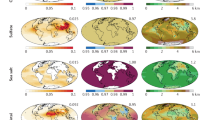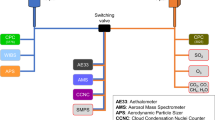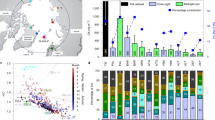Abstract
Anthropogenic aerosols are intricately linked to the climate system and to the hydrologic cycle. The net effect of aerosols is to cool the climate system by reflecting sunlight. Depending on their composition, aerosols can also absorb sunlight in the atmosphere, further cooling the surface but warming the atmosphere in the process. These effects of aerosols on the temperature profile, along with the role of aerosols as cloud condensation nuclei, impact the hydrologic cycle, through changes in cloud cover, cloud properties and precipitation. Unravelling these feedbacks is particularly difficult because aerosols take a multitude of shapes and forms, ranging from desert dust to urban pollution, and because aerosol concentrations vary strongly over time and space. To accurately study aerosol distribution and composition therefore requires continuous observations from satellites, networks of ground-based instruments and dedicated field experiments. Increases in aerosol concentration and changes in their composition, driven by industrialization and an expanding population, may adversely affect the Earth's climate and water supply.
This is a preview of subscription content, access via your institution
Access options
Subscription info for Japanese customers
We have a dedicated website for our Japanese customers. Please go to natureasia.com to subscribe to this journal.
Buy this article
- Purchase on SpringerLink
- Instant access to full article PDF
Prices may be subject to local taxes which are calculated during checkout







Similar content being viewed by others
References
Intergovernmental Panel on Climate Change. Climate Change 2001—The Scientific Basis (contribution of working group I to the Third Assessment Report of the Intergovernmental Panel on Climate Change) (Cambridge Univ. Press, Cambridge, 2001).
Ramanathan, V. et al. Aerosols, climate, and the hydrological cycle. Science 294, 2119–2124 (2001).
Andreae, M. O. et al. External mixture of sea salt, silicates, and excess sulfate in marine aerosols. Science 232, 1620–1623 (1986).
Keeling, C. D. The concentration and isotopic abundances of carbon dioxide in the atmosphere. Tellus 12, 200–203 (1960).
Husar, R. B., Prospero, J. & Stowe, L. L. Characterization of tropospheric aerosols over the oceans with the NOAA AVHRR optical thickness operational product. J. Geophys. Res. 102, 16889–16909 (1997).
Herman, J. R. et al. Global distribution of UV-absorbing aerosol from Nimbus-7/TOMS data. J. Geophys. Res. 102, 16911–16922 (1997).
Prospero, J. M. & Nees, R. T. Impact of the North African drought and El Niño on mineral dust in the Barbados trade wind. Nature 320, 735–738 (1986).
Clarke, A. D. & Charlson, R. J. Radiative properties of the background aerosol: absorption component of extinction. Science 229, 263–265 (1985).
Twomey, S. A., Piepgrass, M. & Wolfe, T. L. An assessment of the impact of pollution on the global albedo. Tellus 36B, 356–366 (1984).
Charlson, R. J. et al. Climate forcing of anthropogenic aerosols. Science 255, 423–430 (1992).
Kiehl, J. T. & Briegleb, B. P. The relative roles of sulfate aerosols and greenhouse gases in climate forcing. Science 260, 311–314 (1993).
Satheesh, S. K. & Ramanathan, V. Large differences in tropical aerosol forcing at the top of the atmosphere and Earth's surface. Nature 405, 60–63 (2000).
Eck, T. F. et al. Measurements of irradiance attenuation and estimation of the aerosol single scattering albedo for biomass burning in Amazonia. J. Geophys. Res. 103, 31865–31878 (1998).
Hansen, J., Sato, M. & Ruedy, R. Radiative forcing and climate response. J. Geophys. Res. 102, 6831–6864 (1997).
Ackerman, A. S. et al. Reduction of tropical cloudiness by soot. Science 288, 1042–1047 (2000).
Kaufman, Y. J. & Fraser, R. S. Confirmation of the smoke particles effect on clouds and climate. Science 277, 1636–1639 (1997).
Nakajima, T. et al. A possible correlation between satellite-derived cloud and aerosol microphysical parameters. Geophys. Res. Lett. 28, 1171–1174 (2001).
Coakley, J. A. Jr, Bernstein, R. L. & Durkee, P. A. Effect of ship stack effluents on cloud reflectance. Science 237, 953–956 (1987).
Kaufman, Y. J. & Nakajima, T. Effect of Amazon smoke on cloud microphysics and albedo. J. Appl. Meteorol. 32, 729–744 (1993).
Rosenfeld, D. TRMM observed first direct evidence of smoke from forest fires inhibiting rainfall. Geophys. Res. Lett. 26, 3105–3108 (1999).
Rosenfeld, D. Suppression of rain and snow by urban and industrial air pollution. Science 287, 1793–1796 (2000).
Boucher, O. & Haywood, J. On summing the components of radiative forcing of climate change. Clim. Dynam. 18, 297–302 (2001).
Chin, M et al. Tropospheric aerosol optical thickness from the GOCART model and comparisons with satellite and Sun photometer measurements. J. Atmos. Sci. 59, 461–483 (2002).
King, M. D. et al. Remote sensing of tropospheric aerosols from space: past, present and future. Bull. Am. Meteorol. Soc. 80, 2229–2259 (1999).
Tanré, D. et al. Remote sensing of aerosol over oceans from EOS-MODIS. J. Geophys. Res. 102, 16971–16988 (1997).
Deuzé, J.-L. et al. Estimate of the aerosol properties over the ocean with POLDER. J. Geophys. Res. 105, 15329–15346 (2000).
Diner, D. J. et al. MISR aerosol optical depth retrievals over southern Africa during the SAFARI-2000 dry season campaign. Geophys. Res. Lett. 28, 3127–3130 (2001).
Veefkind, J. P., de Leeuw, G. & Durkee, P. A. Retrieval of aerosol optical depth over land using two-angle view satellite radiometry during TARFOX. Geophys. Res. Lett. 25, 3135–3138 (1998).
Delene, D. J. & Ogren, J. A. Variability of aerosol optical properties at four North American surface monitoring sites. J. Atmos. Sci. 59, 1135–1150 (2002).
Artaxo, P. et al. Large scale aerosol source apportionment in Amazonia. J. Geophys. Res. 103, 31837–31847 (1998).
Kaufman, Y. J. et al. The Smoke, Clouds and Radiation experiment in Brazil (SCAR-B). J. Geophys. Res. 103, 31783–31808 (1998).
Ramanathan, V. et al. The Indian Ocean Experiment: an integrated analysis of the climate forcing and effects of the great Indo-Asian haze. J. Geophys. Res. 106, 28371–28398 (2001).
Dubovik, O. et al. Variability of absorption and optical properties of key aerosol types observed in worldwide locations. J. Atmos. Sci. 59, 590–608 (2002).
Rotstayn, L. D., Ryan, B. F. & Penner, J. E. Precipitation changes in a GCM resulting from the indirect effects of anthropogenic aerosols. Geophys. Res. Lett. 27, 3045–3048 (2000).
Lohmann, U. & Feichter, J. Impact of sulfate aerosols on albedo and lifetime of clouds: a sensitivity study with the ECHAM4 GCM. J. Geophys. Res. Atmos. 102, 13685–13700 (1997).
Albrecht B. A. Aerosols, cloud microphysics, and fractional cloudiness. Science 245, 1227–1230 (1989).
Penner, J. E., Dickinson, R. E. & O'Neill, C. A. Effects of aerosol from biomass burning on the global radiation budget. Science 256, 1432–1433 (1992).
Bréon, F.-M., Tanré, D. & Generoso, S. Aerosol effect on cloud droplet size monitored from satellite. Science 295, 834–838 (2002).
Wielicki, B. A. et al. Clouds and the earth's radiant energy system (CERES): an earth observing system experiment. Bull. Am. Meteorol. Soc. 77, 853–868 (1996).
Herman, M. et al. Remote sensing of aerosol over land surfaces including polarization measurements and application to POLDER measurements. J. Geophys. Res. 102, 17039–17049 (1997).
Holben, B. N. et al. An emerging ground based aerosol climatology: aerosol optical depth from AERONET. J. Geophys. Res. 106, 12067–12097 (2001).
Prospero, J. M. Long term measurements of the transport of African mineral dust to the Southern US: implications for regional air quality. J. Geophys. Res. 104, 15917–15927 (1999).
Bates T. S. et al. International Global Atmospheric Chemistry (IGAC) project's first aerosol characterization experiment ACE-1: overview. J. Geophys. Res. 103, 16297–16318 (1998).
Takemura, T. et al. Single-scattering albedo and radiative forcing of various aerosol species with a global three-dimensional model. J. Clim. 15, 333–352 (2002).
Luo Y. F. et al. Characteristics of the spatial distribution and yearly variation of aerosol optical depth over China in last 30 years. J. Geophys. Res. 106, 14501–14513 (2001).
Novakov, T., Hegg, D. A. & Hobbs, P. V. Airborne measurements of carbonaceous aerosols on the East Coast of the United States. J. Geophys. Res. 102, 30023–30030 (1997).
Hegg, D. A. et al. Chemical apportionment of aerosol column optical depth off the mid-Atlantic coast of the United States. J. Geophys. Res. 102, 25293–25303 (1997).
Ackerman, T. P. & Toon, O. B. Absorption of visible radiation in atmosphere containing mixtures of absorbing and non-absorbing particles. Appl. Opt. 20, 3661–3668 (1981).
Martins, J. V. et al. Effects of black carbon content, particle size, and mixing on light absorption by aerosol particles from biomass burning in Brazil. J. Geophys. Res. 103, 32041–32050 (1998).
Haywood, J. & Boucher, O. Estimates of the direct and indirect radiative forcing due to tropospheric aerosols: a review. Rev. Geophys. 38, 513–543 (2000).
Jacobson, M. Z. Strong radiative heating due to the mixing state of black carbon in atmospheric aerosols. Nature 409, 695–697 (2001).
Eck, T. F. et al. Characterization of the optical properties of biomass burning aerosols in Zambia during the 1997 ZIBBEE field campaign. J. Geophys. Res. 106, 3425–3448 (2001).
Ross, J. L., Hobbs, P. V. & Holben, B. Radiative characteristics of regional hazes dominated by smoke from biomass burning in Brazil: closure tests and direct radiative forcing. J. Geophys. Res. 103, 31925–31941 (1998).
Liousse, C. et al. A Three-dimensional model study of carbonaceous aerosols. J. Geophys. Res. 101, 19411–19432 (1996).
Prospero, J. M. et al. Environmental characterization of global sources of atmospheric soil dust identified with the NIMBUS-7 TOMS absorbing aerosol product. Geophys. Rev. (in the press).
Sokolik, I. N. & Toon, O. B. Direct radiative forcing by anthropogenic airborne mineral aerosol. Nature 381, 681–683 (1996).
Moulin, C. et al. Control of atmospheric export of dust from North Africa by the North Atlantic oscillation. Nature 387, 691–694 (1997).
Tanré, D. et al. Climatology of dust aerosol size distribution and optical properties derived from remotely sensed data in the solar spectrum. J. Geophys. Res. 106, 18205–18218 (2001).
Clarke, A. D. & Kapustin, V. N. A Pacific aerosol survey, part 1: a decade of data on particle formation, transport, evolution, and mixing in the troposphere. J. Atmos. Sci. 59, 363–382 (2002).
Gao, Y. et al. Seasonal distribution of Aeolian iron fluxes to the global ocean. Geophys. Res. Lett. 28, 29–33 (2001).
Hoppel, W. A. et al. Aerosol size distribution and optical properties found in the marine boundary layer over the Atlantic Ocean. J. Geophys. Res. 95, 3659–3686 (1990).
Smirnov, A. et al. Optical properties of atmospheric aerosol in maritime environments. J. Atmos. Sci. 59, 501–523 (2002).
Levin, Z., Ganor, E. & Gladstein, V. The effects of desert particles coated with sulfate on rain formation in the Eastern Mediterranean. J. Appl. Meteorol. 35, 1511–1523 (1996).
Leon, J. F. et al. Large-scale advection of continental aerosols during INDOEX. J. Geophys. Res. 106, 28427–28439 (2001).
Reiner T. et al. Chemical characterization of pollution layers over the tropical Indian Ocean: signatures of emissions from biomass and fossil fuel burning. J. Geophys. Res. 106, 28497–28510 (2001).
Liao, H. & Seinfeld, J. H. Effect of clouds on direct aerosol radiative forcing of climate. J. Geophys. Res. 103, 3781–3788 (1998).
Formenti, P. et al. Aerosol optical properties and large-scale transport of air masses: observations at a coastal and a semiarid site in the eastern Mediterranean during summer 1998. J. Geophys. Res. 106, 9807–9826 (2001).
Gobbi, G. P. et al. Altitude-resolved properties of a Saharan dust event over the Mediterranean. Atmos. Environ. 34, 5119–5127 (2000).
Kreidenweis, S. M. et al. Smoke aerosol from biomass burning in Mexico: hygroscopic smoke optical model. J. Geophys. Res. 106, 4831–4844 (2001).
Winker, D. M., Couch, R. H. & McCormick, M. P. An overview of LITE: NASA's lidar in-space technology experiment. Proc. IEEE 84, 164–180 (1996).
Heymsfield A. J. & McFarquhar, G. M. Microphysics of INDOEX clean and polluted trade cumulus clouds. J. Geophys. Res. 106, 28653–28674 (2001).
Han, Q., Rossow, W. B. & Lacis, A. A. Near global survey of effective droplet radii in liquid water clouds using ISCCP data. J. Clim. 7, 465–496 (1994).
Boucher, O. GCM estimate of the indirect aerosol forcing using satellite-retrieved cloud droplet effective radii. J. Clim. 8, 1403–1409 (1995).
Feingold, G. et al. Analysis of smoke impact on clouds in Brazilian biomass burning regions: an extension of Twomey's approach. J. Geophys. Res. 106, 22907–22922 (2001).
Feingold, G. et al. The impact of giant cloud condensation nuclei on drizzle formation in stratocumulus: implications for cloud radiative properties. J. Atmos. Sci. 56, 4100–4117 (1999).
Charlson, R. J. et al. Reshaping the theory of cloud formation. Science 292, 2025–2026 (2001).
Feingold, G. & Chuang, P. Y. Analysis of the influence of film-forming compounds on droplet growth: implications for cloud microphysical processes and climate. J. Atmos. Sci, 59, 2006–2018 (2002).
Rosenfeld, D. & Woodley, W. L. K. Deep convective clouds with sustained supercooled liquid water down to −37.5 °C. Nature 405, 440–442 (2001).
Khain, A. P., Rosenfeld, D. & Pokrovsky, A. Simulating convective clouds with sustained supercooled liquid water down to −37.5 °C using a spectral microphysics model. Geophys. Res. Lett. 28, 3887–3890 (2001).
Alpert, P. et al. Quantification of dust-forced heating of the lower troposphere. Nature 395, 367–370 (1998).
Claquin, T. et al. Uncertainties in assessing radiative forcing by mineral dust. Tellus 50B, 491–505 (1998).
Kaufman, Y. J. et al. Satellite and ground-based radiometers reveal much lower dust absorption of sunlight than used in climate models. Geophys. Res. Lett. 28, 1479–1483 (2001).
Bond, T. C., Charlson, R. J. & Heintzenberg, J. Quantifying the emission of light-absorbing particles: measurements tailored to climate studies. Geophys. Res. Lett. 25, 337–340 (1998).
Christopher, S. A. et al. First estimates of the radiative forcing of aerosol generated from biomass burning using satellite data. J. Geophys. Res. 101, 21265–21273 (1996).
Li, Z. & Kou, L. Atmospheric direct radiative forcing by smoke aerosols determined from satellite and surface measurements. Tellus 50B, 543–554 (1998).
Collins, W. D. et al. Simulating aerosols using a chemical transport model with assimilation of satellite aerosol retrievals: methodology for INDOEX. J. Geophys. Res. 106, 7313–7336 (2001).
Satheesh, S. K. et al. A model for the natural and anthropogenic aerosols over the tropical Indian Ocean derived from Indian Ocean Experiment data. J. Geophys. Res. 104, 27421–27440 (1999).
Remer, L. A. et al. Urban/industrial aerosol: ground based sun/sky radiometer and airborne in situ measurements. J. Geophys. Res. 102, 16849–16859 (1997).
Chou, M. D. A solar-radiation model for use in climate studies. J. Atmos. Sci. 49, 762–772 (1992).
Liu M., & Westphal, D. L. A study of the sensitivity of simulated mineral dust production to model resolution. J. Geophys. Res. 106, 18099–18112 (2001).
Fraser, R. S., Kaufman, Y. J. & Mahoney, R. L. Satellite measurements of aerosol mass and transport. Atmos. Environ. 18, 2577–2584 (1984).
Hsu, N. C., Herman, J. R. & Weaver, C. Determination of radiative forcing of Saharan dust using combined TOMS and ERBE. J. Geophys. Res. 105, 20649–20661 (2000).
Torres O. et al. A long-term record of aerosol optical depth from TOMS observations and comparison to AERONET measurements. J. Atmos. Sci. 59, 398–413 (2002).
Chu, D. A. et al. Validation of MODIS aerosol optical depth retrieval over land. Geophys. Res. Lett. (in the press).
Remer, L. A. et al. Validation of MODIS aerosol retrieval over ocean. Geophys. Res. Lett. (in the press).
Kaufman, Y. J. et al. Remote sensing of tropospheric aerosol from EOS-MODIS over the land using dark targets and dynamic aerosol models. J. Geophys. Res. 102, 17051–17067 (1997).
Fraser, R. S. & Kaufman, Y. J. The relative importance of aerosol scattering and absorption in remote sensing. IEEE J. Geosci. Rem. Sens. GE-23, 525–633 (1985).
Fouquart, Y. et al. Observations of Saharan aerosols: results of ECLATS field experiment. II: Broadband radiative characteristics of the aerosols and vertical radiative flux divergence. J. Clim. Appl. Meteorol. 25, 28–37 (1986).
Mishchenko, M. I. & Travis, L. D. Satellite retrieval of aerosol properties over the ocean using polarization as well as intensity of reflected sunlight. J. Geophys. Res. 102, 16989–17013 (1997).
Chowdhary, J., Cains, B. & Travis, L. D. Case studies of aerosol retrieval over the ocean from multiangle, multispectral photopolarimetric remote sensing data. J. Atmos. Sci. 59, 383–397 (2002).
Acknowledgements
We thank F. M. Bréon, M. Chin, O. Dubovik, G. Feingold, P. Formenti, M. Herman, D. Herring, B. N. Holben, S. Mattoo, L. Remer and D. Rosenfeld for measurements and calculations used in this paper and for editorial comments. POLDER was a CNES/NASDA project; TOMS and MODIS are NASA projects.
Author information
Authors and Affiliations
Corresponding author
Rights and permissions
About this article
Cite this article
Kaufman, Y., Tanré, D. & Boucher, O. A satellite view of aerosols in the climate system. Nature 419, 215–223 (2002). https://doi.org/10.1038/nature01091
Issue Date:
DOI: https://doi.org/10.1038/nature01091
This article is cited by
-
Historical footprints and future projections of global dust burden from bias-corrected CMIP6 models
npj Climate and Atmospheric Science (2024)
-
Distribution and concentration pathway of particulate pollution during pandemic-induced lockdown in metropolitan cities in India
International Journal of Environmental Science and Technology (2024)
-
Impact of Types of Aerosol and Meteorological Conditions on Rain Rate Over India
Pure and Applied Geophysics (2024)
-
Estimation of Particulate Matter (PM2.5) Over Kolkata
Pure and Applied Geophysics (2024)
-
Introduction to the Special Issue: Geophysics and remote sensing for resources and ecosystem sustainability in an environmentally constrained world
Acta Geophysica (2024)



